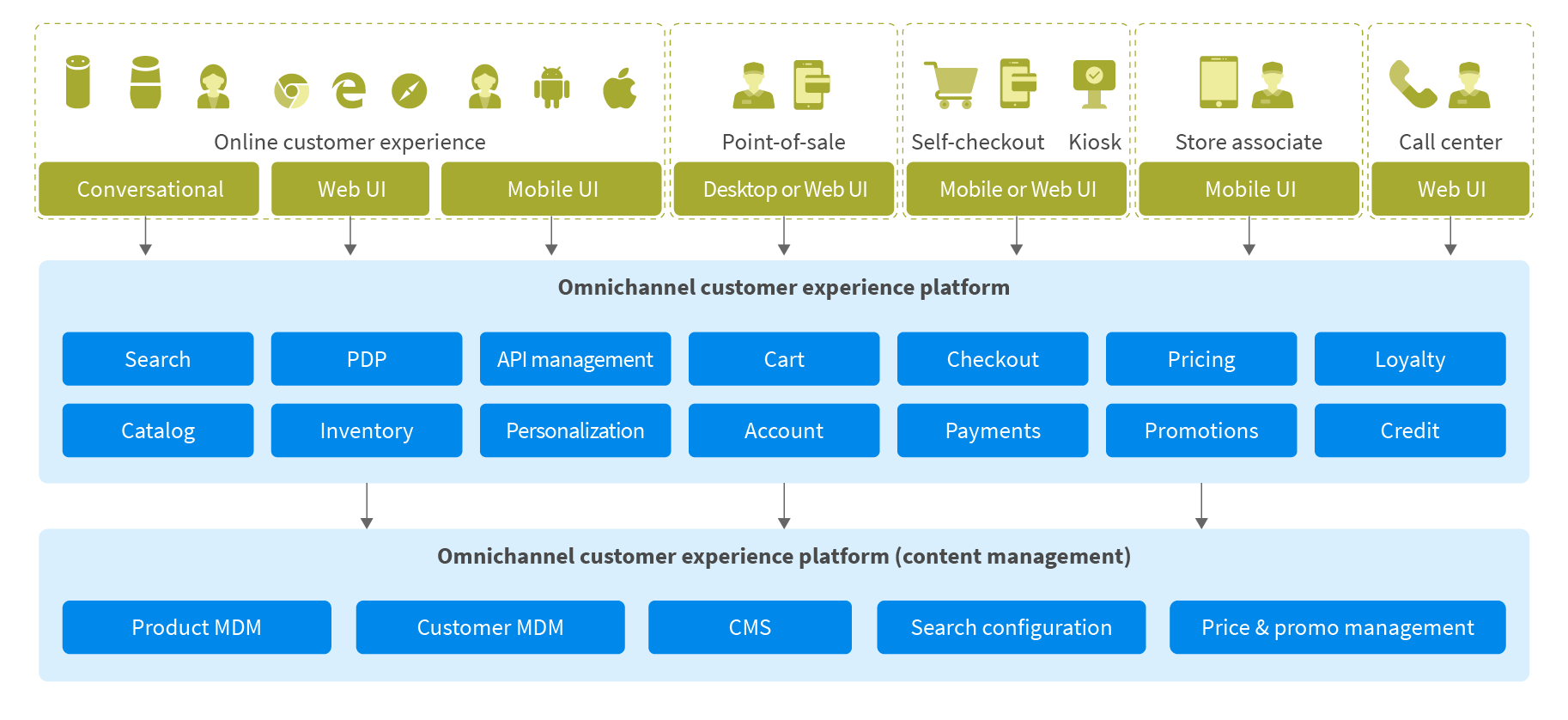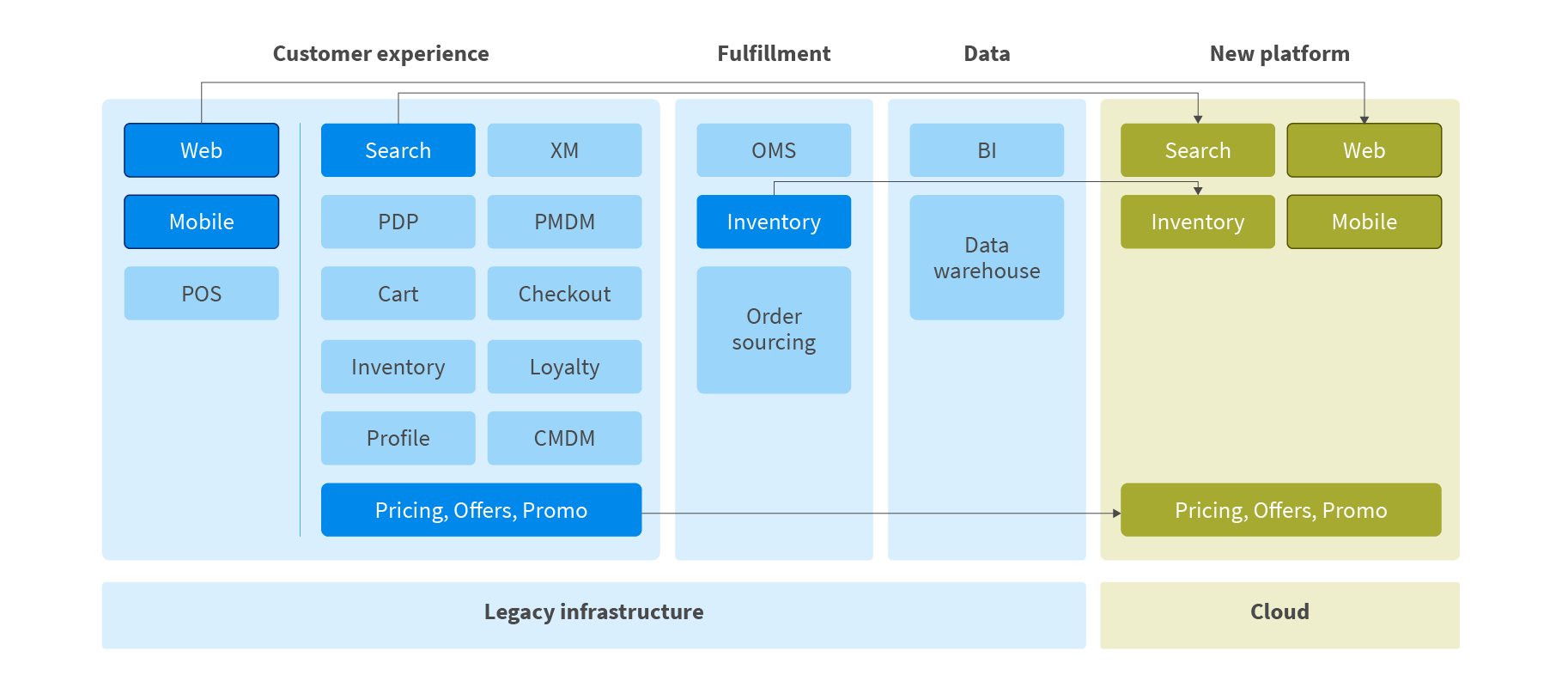
ATG’s black box blocking your e-commerce view? Replatform with microservices
If you want your customers to have a seamless shopping experience no matter where they are or what device they’re using, but you’re stuck with a black box legacy system like Oracle ATG, you may think a true omnichannel experience is beyond your reach.
We have helped many of the top retailers in the US to create true omni-channel experiences for their customers. Many of them poured thousands of hours and millions of dollars into customizing, integrating and tuning it, but legacy systems just don’t meet your needs anymore – and their makers aren’t helping to resolve the issues. Instead of modernizing it, Oracle has Many retailers have found that their mission-critical commerce platform has turned into a monolithic black box impervious to innovation and ridiculously expensive to maintain. Go to the cloud? What cloud? Despite a few workarounds that may allow some cloud implementations, legacy systems have your company stuck in a fog so thick it may feel like you’ll never find a way out.
Replatforming to a microservices platform can help you achieve your goals as you migrate off of ATG. And we can show you how.
It’s past time to migrate off ATG
Why are we telling you about this now? When we first warned, back in 2017, that it was time to get off of ATG, we showed how the platform failed to support real-time inventory, couldn’t scale catalog services and crippled efforts to use the cloud to meet peak performance needs.
What we said then is more accurate now than ever. Hemmed in by ATG – more on how coming up – many large retailers already have migrated off this legacy platform. We believe many more are moving in that direction today, some to avoid renewing their licenses in the near-term and others to dump their data center leases as they migrate onto the cloud.
Nonetheless, many companies feel stuck because they think re-platforming is too time-consuming, risky and expensive even to consider it. But after years helping numerous retail clients get out from under ATG’s ponderous burdens, we’ve discovered that the experience doesn’t have to take long, isn’t particularly risky, and can cost less than sticking with ATG.
Let’s explore in detail why ATG no longer makes the grade:
- Today’s big retailers must build better customer experiences with enhanced features, something ATG and other black box legacy systems can’t do. Any new tricks you can get old platforms to do are entirely up to your team’s internal customization efforts. Legacy technology stacks make implementing new custom features on these monoliths slow and expensive. In the end, customization creep may end up with more business logic being re-written and customized than actually provided by ATG, making routine things like upgrades unreasonably expensive.
- Omnichannel commerce is fundamental to today’s retail experience. But legacy platforms are stuck back in the ‘90s when the web was the only digital touchpoint to worry about. According to Marketing Week, the average consumer in 2003 typically used two touchpoints when buying an item and only 7% regularly used more than four. Today, however, consumers use nearly six touchpoints, with 50% regularly using more than four. Using ATG and other monolithic third-party products for omnichannel commerce poses even more significant challenges, which we’ll get into in a future post.
- Legacy systems like ATG aren’t cloud-native; rather than investing time and effort to shoehorn aging platforms onto the cloud, it makes more sense to retire them and focus future investments in modernization and re-platforming. The legacy behemoth can't be deployed easily through any modern cloud providers, requiring companies instead to load up on hardware to meet peak demands – servers that then sit idle for long stretches of time. It is possible to use brute force to get ATG into the cloud, but such lift-and-shift simply isn’t worth the time and effort involved.
- Perhaps worst of all, ATG’s exorbitant license and maintenance costs represent an ongoing budget drain. With limited budgets, it's much more cost-effective to spend on building out a cloud-based solution rather than try and configure ATG.
Go “headless” for omnichannel
What retailers actually want is a unified omnichannel platform, something legacy ATG struggles to be. But that’s where a headless microservices commerce component option can shine. It can be deployed in the cloud and at the edge, with UI components to cover the web, mobile apps, and the point of sale.

But the rapid pace of technological change makes less monolithic approaches more appealing. Instead, an API-first, headless commerce solution built on microservices is becoming the new e-commerce platform of choice.
Here are some of the key technology strategy principles to keep in mind:
- Microservices
- Microservices separate the platform’s various components into discrete “services” connected by APIs. These increase speed and flexibility because they’re built separately rather than being modified within a one-size-fits-all black box. Teams can work on a piece of the puzzle independently, fitting each bespoke service into the whole puzzle only when it’s tested and ready.
- Cloud
- A key feature of headless commerce re-platforming is the ability to take advantage of on-demand cloud resources rather than building for peak needs in-house. Retailers who see a ten-fold increase in business on just a few days like Cyber Monday each year find their legacy systems’ architectural constraints make it difficult to take advantage of the cloud’s key capabilities. But with headless e-commerce, you can maintain a minimal base level of servers on-site and then spin up additional capacity when usage peaks. In addition to readily available hosted services for a variety of cloud-based technologies – including databases, message queues, and a microservices platform – as well as more advanced features like serverless computing, increase developer productivity, shorten implementation times, reduce costs, and increase innovation speed.
- Edge and “fog” computing
- A key advantage of a microservice architecture is that the online platform can be deployed for an in-store experience. The same code allows store servers to become a uniformly-managed "fog" with necessary microservices deployed locally for a unified customer experience in the event store connectivity to the cloud is down. Microservices also help to reduce the latency of serving requests because all the business logic and data are available at or near the edge. The actual edge, such as PoS devices, and other in-store peripherals also can be unified from a management and deployment perspective, leading to the implementation of intriguingly advanced use cases beyond unified commerce – for example, in-store real-time analytics.
- Mix buy with build
- Building is expensive, but bespoke services are only worth it if you need a differentiated experience. So for commodity services that don’t need to be customized, buying is cheaper and faster. Fortunately, there are a variety of buying options, including:
- SaaS, or software as a service. Only buy what you need from the smorgasbord of software tools on the market and only pay when you use it.
- Licensed tools. Another form of buying what you need, but you pay for use during a specified period of time.
- Open-source tools. If your needs are basic, there may be any number of no-charge open source projects that already provide the functionality you seek. In some cases, you can buy licenses for customized versions of these tools.
- Building is expensive, but bespoke services are only worth it if you need a differentiated experience. So for commodity services that don’t need to be customized, buying is cheaper and faster. Fortunately, there are a variety of buying options, including:
As you build around your purchased pieces to weave together that mixed solution, we suggest focusing on these key build principles:
- Go with open source wherever possible
- Stick with the cloud
- Weave everything together with APIs
- Always connect back to data
Rapid or incremental – it’s up to you
Once you’ve decided to re-platform, there are two main paths to accomplish this headless commerce component approach – rapid and incremental.
Rapid re-platforming over the course of just a few months or at most a year involves one big-bang release of the new platform without any interim steps. The key business drivers behind this admittedly riskier approach are costs – either your ATG license is about to expire or the lease is ending on your data center. If you don’t want to throw any more money at your legacy system, rapid re-platforming spins up your new headless component platform in a jiffy.
Benefits: You make the leap to a modern platform quickly, getting out from under expensive data center leases and ongoing ATG costs.

But speed isn’t always of the essence. In fact, slow and steady may be the better approach.
Incremental re-platforming can take up to three years, slowly stripping away services from ATG with the ultimate goal of getting rid of the legacy platform entirely. Working methodically, you can identify which domains and features require customization and then develop each component one by one, conducting A/B testing as you go along.
Focus first on components that can best take advantage of scalability and cloud resources, or areas requiring the most significant change because of new functional or performance requirements. Good initial candidates could include services that are loosely connected to the rest of the system or that require expensive licenses that can be retired after the transition.
Benefits: Incremental re-platforming involves much less risk; it’s easy to back out a change if a problem crops up because ATG is still in place until you get the new component functioning. A key benefit to moving incrementally is that you can A/B test each component as you go along, verifying the value of the change and bolstering the overall business case for re-platforming.
An additional benefit is that transition costs are split across several budget cycles, easing the financial sting of the process. Ultimately, this slow and steady approach is less disruptive, allowing ATG to remain in place until it’s no longer needed.
How we can help make the re-platforming leap
The advantages are clear: A headless commerce component approach provides a modern e-commerce platform that legacy ATG just can’t achieve. If you want to lower costs, increase your flexibility, enjoy differentiated experiences and deploy your choice of best-of-breed tools, it’s time to move beyond a purely build or buy scenario. Sound too risky? Engage an experienced engineering services company like Grid Dynamics that’s been through the process and knows how to guide you around any potential hazards.
In addition to building your differentiated solutions, a company like ours acts as an accelerator to decrease the overall cost of implementation and reduce time to deployment. Once you’ve got your customized components sorted, you can buy commodity pieces from best-of-breed platforms to fill in gaps.
Get in touch with Grid Dynamics for a streamlined re-platforming experience.

